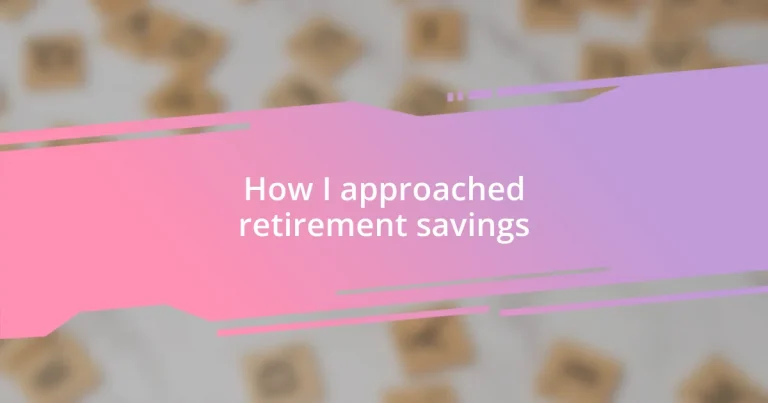Key takeaways:
- Establish clear retirement savings goals based on personal aspirations and experiences you want to enjoy, adapting your strategy as your dreams evolve.
- Assess your current financial situation comprehensively, including income, expenses, assets, and debts, to create a strong foundation for your retirement plan.
- Regularly monitor and adjust your savings and investment strategies to stay on track, being flexible to respond to life’s unexpected changes and expenses.

Understanding retirement savings goals
When I first started thinking about retirement savings, I’ll be honest—I felt overwhelmed. With so many numbers flying around, it was challenging to determine how much I really needed to save. One question that stood out to me was: “What kind of lifestyle do I envision for myself in retirement?” This simple yet profound inquiry helped me set clear savings goals.
As I delved deeper into my plans, I realized that it wasn’t just about the dollars and cents but about the experiences I wanted to enjoy. For instance, I dreamed of traveling and spending time with family. This understanding pushed me to reevaluate my contributions and focus on not just saving but effectively growing my investments. Have you thought about what brings you joy in retirement? Identifying these moments can dramatically shape your savings objectives.
Another aspect I found crucial was the timeline of my retirement. The earlier I started saving, the more options I had later on. I remember having a candid discussion with a friend’s father who retired early. He simply said, “Start now, trust your future self.” It was a lightbulb moment for me, illustrating that my retirement savings goals could be flexible and evolve as my dreams changed. How are you planning to adapt your savings strategy over time?

Assessing your current financial situation
Understanding where you currently stand financially is essential for any retirement planning journey. I remember sitting down one afternoon with a cup of tea, spreadsheets sprawled out, and feeling the weight of my financial reality. It was a moment of clarity when I took stock of my assets and liabilities.
Start by listing the following key areas:
- Current income and expenses
- Savings accounts and retirement accounts (like 401(k) or IRA)
- Investment portfolio and real estate assets
- Debts (credit cards, mortgage, student loans)
- Emergency fund status
This snapshot allowed me to see what I needed to improve and where I was doing well. It’s natural to feel a mix of anxiety and motivation as you confront your numbers. Ultimately, this assessment serves as the foundation on which you can build your retirement strategy with confidence.

Choosing the right retirement accounts
When I began to explore retirement accounts, it felt like entering a maze with many pathways. I quickly discovered that different accounts offer unique benefits—like tax advantages or contribution limits. For instance, opening a 401(k) was a logical choice for me because my employer matched contributions, meaning “free money” to bolster my savings. Have you looked into employer-sponsored plans? They can significantly boost your retirement nest egg without extra effort.
As I evaluated other options, I found IRAs—specifically Roth IRAs—quite appealing. With a Roth IRA, I pay taxes on my contributions now, allowing for tax-free withdrawals in retirement. This strategy felt right for me, considering my belief that I’d be in a higher tax bracket down the line. Understanding how each account aligns with my financial goals really simplified my decision-making. Just remember, it’s about what works best for your unique situation.
I believe it’s essential to diversify my retirement accounts. By mixing different types, I can optimize both growth and tax benefits, creating a more balanced approach to my savings. I recall sitting at my dining table with my partner, excitedly mapping out our contributions across these accounts while discussing how each one serves our future plans. It was thrilling to see how our choices could potentially lead to a family vacation in the mountains or a cozy retirement home by the beach. What dreams do you hope your retirement savings will help you achieve?
| Account Type | Key Features |
|---|---|
| 401(k) | Employer match, tax-deferred growth |
| Roth IRA | Tax-free withdrawals, flexible contributions |
| Traditional IRA | Tax-deductible contributions, tax-deferred growth |
| Simplified Employee Pension (SEP) IRA | Large contribution limits for self-employed or small business owners |

Developing a tailored savings strategy
When it came to developing a tailored savings strategy, I realized that one size definitely does not fit all. I remember brainstorming a list of my retirement goals on a sunny afternoon, feeling both hopeful and a bit overwhelmed. It struck me how crucial it was to align my savings strategy with my personal aspirations, whether that was traveling the world or enjoying quiet evenings at home with family. What are your dreams for retirement, and how might they shape your savings plan?
Next, I explored my risk tolerance, which guided my investment choices. I recall standing at my window, looking out at life in my neighborhood and contemplating my own comfort with market fluctuations. My preference for moderate risk made me lean toward a mix of stocks and bonds, aiming for a balanced growth approach. Have you thought about how much risk you’re willing to take? It can directly influence the returns you achieve and the peace of mind you have as you save.
Lastly, I set regular check-ins for myself to reassess my strategy. It was a habit that I formed—sitting down every six months to review my progress. One particularly chilly evening, I found reassurance in seeing how far I had come. I adjusted my contributions and made minor tweaks based on my evolving goals. It was empowering to realize that my strategy was not static; it could grow and change just like I did. How often do you reassess your savings strategy? Regular updates can vastly improve your financial well-being and keep you aligned with your retirement objectives.

Optimizing investments for retirement
When I started investing for retirement, I quickly learned that optimizing my portfolio was key. I remember the nervous excitement of my first investment decision—choosing a blend of index funds and mutual funds. I liked the idea of index funds, simple and cost-effective, but I also pondered if they could really provide the growth I needed. Have you considered how different fund types can impact your retirement savings? Each option has its own strengths that can shape the trajectory of your investments.
As I continued to educate myself, I embraced the importance of regular rebalancing. I can vividly recall one afternoon, surrounded by spreadsheets and coffee, when I took the time to adjust my allocations to keep my risk level in check. It felt rewarding to reclaim control over my investments, ensuring that my portfolio didn’t drift too far from my original goals. Have you ever looked at your investment mix and felt it needed a refresh? Taking a step back can be hugely beneficial and allow you to tailor your approach to your changing life circumstances.
In my journey, I also focused on minimizing fees, which can really eat into profits over time. I distinctly remember calculating how even small percentage differences could mean thousands of dollars gone over the long haul. That moment was an eye-opener—by simply opting for low-cost funds, I could keep more of my earnings for the future. Have you ever thought about how fees impact your investments? Cutting costs can be a game-changer in maximizing the money you have available at retirement.

Monitoring and adjusting your plan
As I navigated my retirement savings journey, I quickly realized that monitoring my plan wasn’t just a formality; it was an essential part of staying on track. I recall sitting at my kitchen table one evening with a hot cup of tea, reviewing my investment statements. That simple act of reflection not only put things into perspective but also revealed areas where I could optimize my contributions. Have you ever felt the comfort of knowing exactly where you stand with your finances? It’s a reassuring feeling that encourages proactive decision-making.
Adjusting my savings plan became a natural extension of these check-ins. During one of my assessments, I noticed that I was on pace to hit my goals sooner than I had projected, which led me to consider increasing my contributions. The thrill of making that decision was palpable. I began to imagine all the possibilities that could unfold as I ramped up my savings. In your journey, have you stopped to think about the potential rewards of adjusting your savings in response to your progress? It’s amazing how even slight changes can lead to significant growth over time.
I also learned the importance of being flexible with my strategy. I vividly remember a moment when changes in the economy reshaped my outlook on retirement planning. I felt a mix of anxiety and determination as I recalibrated my investments to reflect a more cautious approach. Recognizing that life—and finances—are inherently unpredictable helped me embrace this adaptability. How often do you find yourself reevaluating your plans in light of new information? Cultivating this mindset can not only enhance your financial strategy but also give you confidence in navigating the unexpected twists and turns ahead.

Preparing for unexpected expenses
When it comes to preparing for unexpected expenses, I learned early on that having a financial buffer was essential. I still remember the day my car broke down unexpectedly; the repair costs were staggering. It was a stark reminder that life has its surprises, and being financially prepared can make all the difference. Have you ever faced an unplanned expense that left you scrambling? Establishing an emergency fund has truly become my safety net.
Moreover, I made sure to regularly review my savings and adjust my budget accordingly. One month, I noticed an unusual spike in my utility bills, which prompted me to analyze my spending habits. I quickly adjusted my budget to account for those fluctuations, freeing up crucial funds to beef up my savings. How often do you evaluate your expenses? This practice has allowed me to stay ahead and ensure I’m ready for whatever life throws my way.
Another strategy I embraced was to set aside a small percentage of my income for unexpected expenses, almost like a mini-savings account. It felt empowering to watch that fund grow, knowing it was there for uncertain moments. I still recall the peace of mind I felt when a friend needed a last-minute loan, and I was able to help because I had that cushion. Isn’t it freeing to know you have a little extra security? Preparing for the unpredictability of life can truly ease your stress in times of need and enhance your overall financial resilience.














